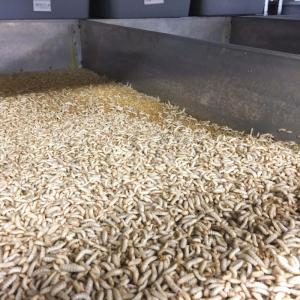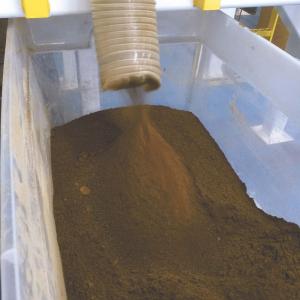Fly Larvae Turned Into Fish Food
An Ohio company is turning black fly larvae into high quality feed for fish, reptiles and exotic birds. The black fly larvae convert waste food and meat byproducts into high protein feed. Initially marketed for specialty markets like zoos and exotic pet owners, the high protein feed will soon hit other markets.
“We are bringing in 6 tons of material a day to feed the flies and larvae,” says Cheryl Preyer, EnviroFlight, LLC. “We are running at full commercial scale and trying various feedstocks. Our pilot plant can be expanded with modules, but our next plant will shoot for 40 tons of feedstock initially. Eventually, it will handle 100 tons of feedstock a day.”
Preyer explains that while the output is a high protein food regardless of input, the fatty acid profile shifts depending on the source. She says the larvae can handle food waste that otherwise might go to the landfill.
“We had a trial using a batch of material that had sheared metal parts in it, and the larvae just ate around the metal,” says Preyer.
EnviroFlight has patented technology to breed black flies inside year round, hatching out eggs and harvesting larvae. Once collected, the larvae is dried and ground for use as feed. The larvae-based feed has more than 40 percent protein and 46 percent fat. The fat can be easily removed for other uses. When the oils are extracted, protein jumps to 70 percent.
Glen Courtright says most of their inputs are free. The company plans to produce 1.2 million pounds of usable protein per acre per year. By comparison, an acre of high yielding soybeans produces only 500 lbs.
Demand is equally huge. Fish farms alone are estimated to need 158 million pounds of feed per day. Supplying that need has resulted in over fishing worldwide. Insect larvae are a natural diet for fish.
The larvae eat twice their body weight and expand about 5,000 times in 2 weeks. Larvae eat about 90 percent of the food provided to them, leaving behind a fiber byproduct called frass. It can be used as a low-fat feed or as a high quality 5-3-2 plant fertilizer.
The only thing holding back wide-scale production and use of the company’s product is federal regulatory approval. Ironically, current feed rules are geared toward keeping bugs out of animal feed.
“We had considered licensing our technology, but have taken that off the table,” says Preyer. “We are now looking at strategic partnerships to expand, as we are selling our entire production.”
Contact: FARM SHOW Followup, EnviroFlight, LLC, 303 North Walnut St., Yellow Springs, Ohio 45387 (ph 937 767-1988; cheryl@enviroflight.net; www.enviroflight.net).

Click here to download page story appeared in.
Click here to read entire issue
Fly Larvae Turned Into Fish Food MISCELLANEOUS EQUIPMENT Miscellaneous An Ohio company is turning black fly larvae into high quality feed for fish reptiles and exotic birds The black fly larvae convert waste food and meat byproducts into high protein feed Initially marketed for specialty markets like zoos and exotic pet owners the high protein feed will soon hit other markets “We are bringing in 6 tons of material a day to feed the flies and larvae ” says Cheryl Preyer EnviroFlight LLC “We are running at full commercial scale and trying various feedstocks Our pilot plant can be expanded with modules but our next plant will shoot for 40 tons of feedstock initially Eventually it will handle 100 tons of feedstock a day ” Preyer explains that while the output is a high protein food regardless of input the fatty acid profile shifts depending on the source She says the larvae can handle food waste that otherwise might go to the landfill “We had a trial using a batch of material that had sheared metal parts in it and the larvae just ate around the metal ” says Preyer EnviroFlight has patented technology to breed black flies inside year round hatching out eggs and harvesting larvae Once collected the larvae is dried and ground for use as feed The larvae-based feed has more than 40 percent protein and 46 percent fat The fat can be easily removed for other uses When the oils are extracted protein jumps to 70 percent Glen Courtright says most of their inputs are free The company plans to produce 1 2 million pounds of usable protein per acre per year By comparison an acre of high yielding soybeans produces only 500 lbs Demand is equally huge Fish farms alone are estimated to need 158 million pounds of feed per day Supplying that need has resulted in over fishing worldwide Insect larvae are a natural diet for fish The larvae eat twice their body weight and expand about 5 000 times in 2 weeks Larvae eat about 90 percent of the food provided to them leaving behind a fiber byproduct called frass It can be used as a low-fat feed or as a high quality 5-3-2 plant fertilizer The only thing holding back wide-scale production and use of the company’s product is federal regulatory approval Ironically current feed rules are geared toward keeping bugs out of animal feed “We had considered licensing our technology but have taken that off the table ” says Preyer “We are now looking at strategic partnerships to expand as we are selling our entire production ” Contact: FARM SHOW Followup EnviroFlight LLC 303 North Walnut St Yellow Springs Ohio 45387 ph 937 767-1988; cheryl@enviroflight net; www enviroflight net
To read the rest of this story, download this issue below or click
here to register with your account number.








